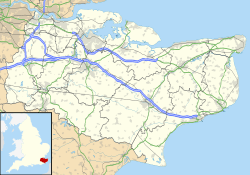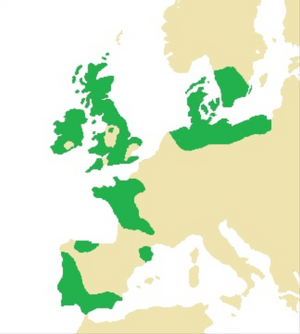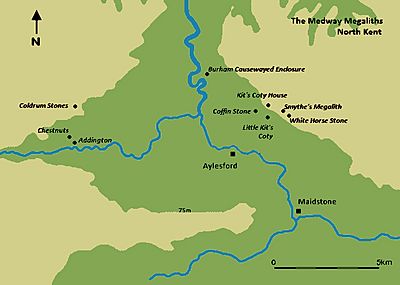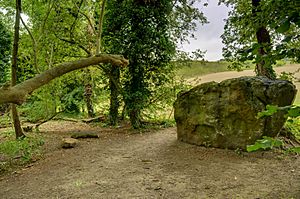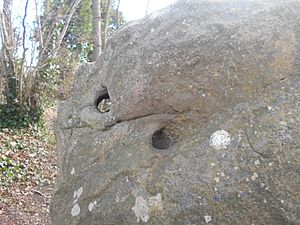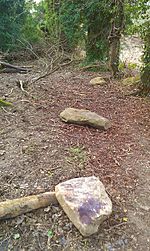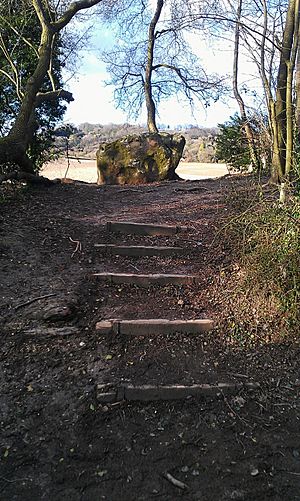White Horse Stone facts for kids
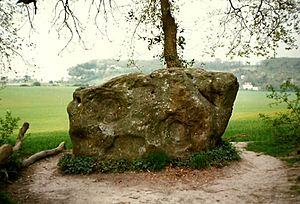
The Upper White Horse Stone
|
|
| Coordinates | 51°18′54″N 0°30′53″E / 51.314969°N 0.514735°E |
|---|---|
| Type | Monolith; putative Long barrow |
The White Horse Stone refers to two large stones found on Blue Bell Hill in Kent, England. These stones are called sarsens, which are very hard, natural rocks. One stone, the Lower White Horse Stone, was broken up before 1834. After it was gone, the other stone, the Upper White Horse Stone, took its name and the old stories linked to it.
Archaeologists think these stones might have been part of ancient burial mounds called chambered long barrows. These mounds were built around 4,000 to 5,000 years ago during the Early Neolithic period in Britain. This was a time when people in Britain started farming.
If the White Horse Stones were part of these burial mounds, they were built by early farming communities. These communities had just learned about agriculture from people in Europe. Building long barrows was a common practice across Europe during the Neolithic period. There was a special group of these mounds near the River Medway in Kent, known as the Medway Megaliths.
The White Horse Stones are on the east side of the Medway River. Other nearby burial mounds include Little Kit's Coty House, Kit's Coty House, and the Coffin Stone. On the west side of the river are the Coldrum Long Barrow, Addington Long Barrow, and Chestnuts Long Barrow. Archaeologists have also found an ancient house from the Early Neolithic period near the White Horse Stone.
By the 1800s, people who studied old things, called antiquarians, thought the Lower White Horse Stone might have been named after the White Horse of Kent. They believed this was the flag of the legendary Anglo-Saxon warriors, Hengest and Horsa. However, later studies did not agree with this idea. After the Lower Stone was destroyed, its stories moved to the Upper White Horse Stone. Since the 1980s, some modern religious groups, like the Odinic Rite, see the Upper White Horse Stone as a sacred site. They connect it to the stories of Hengest and Horsa and the Anglo-Saxon arrival in Britain. These groups hold ceremonies there and work to protect the stone from damage and new buildings.
Contents
What was life like in the Early Neolithic?
The Early Neolithic period was a time of big changes in Britain. Between 4500 and 3800 BCE, people in the British Isles started farming instead of hunting and gathering. This new way of life came from continental Europe. It's not clear if new people moved to Britain or if local people just learned new farming methods. Kent was an important area for new arrivals because it was close to Europe and had the River Thames.
Britain was mostly covered in forests back then. Large-scale forest clearing in Kent didn't happen until much later, in the Late Bronze Age. Near the White Horse Stone, the land was likely covered in trees like oak, ash, and hazel. Most people in Britain during this time were probably pastoralists, meaning they herded cattle. They likely moved around a lot, rather than living in one place.
The Medway Megaliths: Ancient Tombs
The Early Neolithic was the first time people in Western Europe built huge structures. These included chambered long barrows. These were long, oval mounds of earth with a chamber built inside one end. Some chambers were made of wood, but others used very large stones called "megaliths."
These long barrows often served as tombs. They held the remains of many people from the same community. These stone tombs were built all along the coast of Western Europe. This building style came to Britain from Europe in the early 4th millennium BCE. While some stone buildings existed before them, these chambered long barrows were the first widespread use of stone in construction by humans.
The Medway Megaliths are now in ruins, but when they were built, they were some of the biggest and most impressive burial monuments in Britain. They are located along the River Medway in the North Downs. They are the only group of megalithic monuments in eastern England. Experts like Brian Philp and Mike Dutto call them "some of the most interesting and well known" ancient sites in Kent.
The Medway Megaliths are split into two groups. One group is west of the River Medway, and the other is on Blue Bell Hill to the east. The two groups are about 8 to 10 kilometers (5 to 6 miles) apart. The western group includes Coldrum Long Barrow, Addington Long Barrow, and the Chestnuts Long Barrow. The eastern group has Smythe's Megalith, Kit's Coty House, and Little Kit's Coty House. Other stones, like the Coffin Stone and White Horse Stone, might also have been part of these structures. We don't know if they were all built at the same time or if they had different uses.
All the Medway long barrows followed a similar plan. They were built facing east to west. Each had a stone chamber at the eastern end of the mound. They likely had a stone front at the entrance. The chambers were very tall, up to 3 meters (10 feet) high. They were built from sarsen stone, which is a very hard stone found naturally in Kent. Early builders chose these stones and moved them to the building sites.
These shared features show that the Medway Megaliths were built by a strong local community. They are unique in Britain. However, like other groups of long barrows, there were also small differences between them. For example, Coldrum is rectangular, and the Chestnuts Long Barrow has a special front. These differences might mean the tombs were changed over time.
The builders were probably influenced by older tomb designs. We don't know if these builders were local or if they moved to the Medway area. Archaeologists have different ideas about where the design came from. Some think it came from the Low Countries, others from Scandinavia or Germany. Paul Ashbee noted that their close grouping was like other tomb traditions in Northern Europe. He stressed that the Medway Megaliths were part of a widespread European building style.
The White Horse Stones: What We Know
The Lower White Horse Stone
The Lower White Horse Stone used to stand about 300 meters (980 feet) west of the Upper White Horse Stone. It was near where the Pilgrims' Way crossed the road from Rochester to Maidstone, which is now the A229 road. Experts think the site of this stone is now under the A229. This stone was also called "The Kentish Standard Stone." It was made of sarsen stone and was broken up before 1834. It's possible it was part of an old burial mound, but this is not certain.
The Upper White Horse Stone
The Upper White Horse Stone is about 2.9 meters (9.5 feet) long, 1.65 meters (5.4 feet) high, and 0.6 meters (2.0 feet) thick. It is also a sarsen stone. The stone is in a small wooded area called Westfield Wood, next to the Pilgrims' Way. It's east of the A229 road. You can reach it by going behind a nearby petrol station and following the Pilgrim's Way.
The Upper White Horse Stone got its name from the destroyed Lower White Horse Stone. This was first written about in 1927. Some people think one end of the stone looks like a face because of its natural shape. It is a scheduled monument, which means it's protected by law.
It's possible that the Upper White Horse Stone was once part of a burial mound that has since been destroyed. However, this is not certain. Some experts think it looks like a "chamber wallstone" similar to those at Coldrum and Kit's Coty House. But there is no sign of an earth mound around it. Nine smaller stones stretch about 10 meters (33 feet) west from the White Horse Stone. These smaller stones might not have been placed there in ancient times. They could have been moved there later by farmers who found them in their fields.
Ancient Buildings Nearby
Near the White Horse Stone, archaeologists found another ancient burial mound called Smythe's Megalith in 1822. This mound contained pieces of human bones, including parts of a skull, ribs, and limb bones. After farmers found it, the chamber of this mound was destroyed. Now, nothing of it can be seen. Other sarsen stones have been found nearby, which might be parts of other destroyed burial mounds.
To the south of the White Horse Stone, archaeologists found an Early Neolithic building. It was built between 4110-3820 and 3780-3530 BCE. This building was 18 meters (59 feet) long and 8 meters (26 feet) wide. It was a longhouse, a type of building found across Europe. If it was a home, it would have been for a small family. A smaller, round building was also found nearby, but it was likely from a later period.
One archaeologist, Timothy Champion, noted that these buildings don't quite fit the idea that Early Neolithic people were always moving. He suggested the longhouse might have been used for community events or ceremonies, not just as a home. The archaeologists who found these buildings thought they might have been "houses of the living" that could be seen from the "houses of the dead" (the burial mounds). Or, the longhouse might have been used for preparing the dead or for community feasts.
Later History and Stories
About 200 meters (660 feet) from the ancient houses, a settlement was built later, during the Late Bronze Age and Iron Age. This settlement had several round houses and deep pits dug into the chalk. These pits might have been used to store grain. Later, they were filled with pottery, iron objects, animal bones, and even two human burials. Archaeologists think these items were placed there for special reasons, perhaps as part of a ritual.
Old Stories and Researchers
In 1834, a researcher named S. C. Lampreys wrote that the "White Horse Stone" (meaning the Lower White Horse Stone) had been "broken into pieces." He also described where the stone "lay," suggesting it was lying down before it was destroyed.
Lampreys wrote about a "tradition" that after the legendary warriors Hengest and Horsa fought a battle, their battle flag, which had a white horse on it, was found at the stone. Lampreys didn't say if he thought this story was true. This was the first time the link between the stone and Hengest and Horsa was written down. Later, Ronald Jessup said that stories linking the stone to the "White Horse of Kent" were "without foundation" and "nonsense."
In 1842, Douglas Allport included a picture of the Lower White Horse Stone in his book about Maidstone. In the 1840s, Beale Post wrote about the White Horse Stone in a manuscript that was never published. He gave four ideas for how the stone got its name:
- The White Horse banner of the Saxons fell on the stone after a battle.
- The sun hitting the stone at a certain angle makes a shadow that looks like a horse.
- Ancient druids sacrificed a white horse on it.
- Someone riding a white horse was killed near it.
Post also drew a sketch of the Lower White Horse Stone.
In 1924, archaeologist O. G. S. Crawford listed the Upper White Horse Stone with the other Medway Megaliths. William Coles Finch wrote about the site in 1927, including a photo. At that time, the stone was in an open area, not in a wood. By 1970, when archaeologist R. F. Jessup published another photo, trees had grown up around it.
Some folklorists think the White Horse Stone might be the "Druid Stone" mentioned in an old story about a ghost dog. In this story, a vicar and his friend were chased by a large, grey dog to the "Druid Stone."
Modern Connections: Heathenry
The White Horse Stone is now seen as a sacred site by some Folkish Heathens. These are people who follow a modern Pagan religion inspired by the old beliefs of Germanic peoples. They feel a strong connection to their ancestors and history at the site.
One group, the Odinic Rite, was founded in 1973. Its co-founder, John Yeowell, called the White Horse Stone "the birth place of England." He held a ceremony there to make the stone "holy" again. The group sees it as a "symbolic birthplace of the English nation" and a place to remember Hengest and Horsa. Unlike other modern Pagans, these Folkish Heathens see "ancestors" as people they are related to by blood.
Some members of the Odinic Rite believe the White Horse Stone and other Medway Megaliths are connected to "earth energies." They think ancient people were more connected to these energies. Since 1987, the Odinic Rite has held monthly rituals at the stone. They also use it for special events like handfasting weddings and funerals. In 2010, John Yeowell's ashes were scattered at the stone, as he had wished.
In 1987, Odinic Rite members formed the Guardians of the White Horse Stone. This group works to protect the site. They built wooden steps from the Pilgrim's Way to help visitors reach the stone. In the 1990s, they tried to stop the Channel Tunnel Rail Link from being built too close to the stone, but they were not successful.
The Guardians group stopped being active for a while but started up again in 2004. This was because a company called Orange wanted to build a radio tower very close to the stone. The Odinic Rite, along with another group called Woden's Folk, successfully asked the Tonbridge and Malling Council to reject the plan. In 2006, Orange tried again, proposing to move the tower further away. The Guardians again campaigned against it. The White Horse Stone has also been damaged by vandalism sometimes. Members of the Odinic Rite have worked to clean off graffiti without harming the stone.


